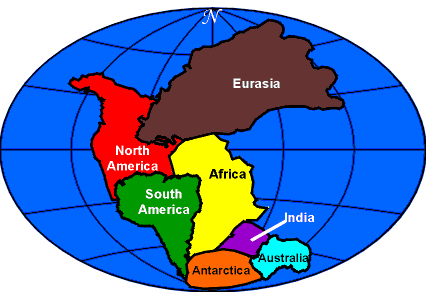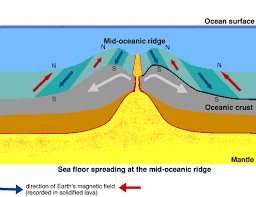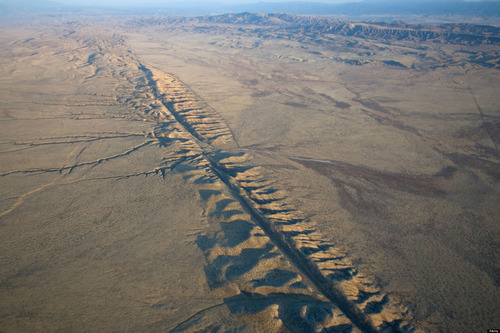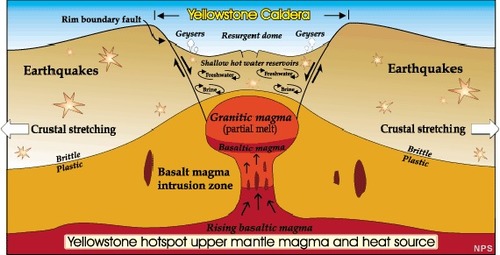Plate tectonics
0.0(0)
0.0(0)
Card Sorting
1/66
Earn XP
Description and Tags
Getting good study habits
Study Analytics
Name | Mastery | Learn | Test | Matching | Spaced |
|---|
No study sessions yet.
67 Terms
1
New cards
When and who first proposed the theory of continental drift?
Alfred Wegener in 1915
2
New cards
What book did Wegener publish?
The origins of continents and oceans
3
New cards
What was the continental drift hypothesis?
1. There used to be a super continent called Pangaea and it started breaking apart about 700 million years ago
2. The continents "drifted" to present positions
3. Continents "broke" through the earths crust
2. The continents "drifted" to present positions
3. Continents "broke" through the earths crust
4
New cards
What evidence did Wegener use to support his hypothesis?
1. The continents fit together
2. Fossils match across the sea
3. Rock type and structures match
4. Ancient climates
2. Fossils match across the sea
3. Rock type and structures match
4. Ancient climates
5
New cards
Why is the continents fitting together one of Wegener's points?
They fit together so perfectly, it couldn't be a coincidence

6
New cards
What is a mesosaurus and where were its fossils found?
A sharp-toothed, freshwater reptile found in South America and Africa
7
New cards
What are cynognathus and lystrosuarus and where were their fossils found?
A mammal like reptile found throughout continents in the southern hemisphere, separate by ocean
8
New cards
What is a glossopteris and where were its fossils found?
A fern found in South America, Africa, Australia, India and Antartica
9
New cards
What did Wegener mean when he said "ancient climates"?
The presence of glaciers from before left rock markings when they retracted or advanced
10
New cards
What is paleoglaciation?
It refers both to the extent of ancient glaciers and to the rock markings they have left behind
11
New cards
Where was paleoglaciation found?
In parts of the world that are now tropical (Example: India, Africa)
12
New cards
What did Wegener notice about mountain ranges?
Some began on one continent, end at the coastline, and then appear to begin in another continent across the ocean
13
New cards
How did Wegener know these mountain ranges used to be connected?
There were similarities in rock structures and the age of rocks in mountain ranges that were across continents
14
New cards
Why did no one believe Wegener at first?
He couldn't prove why the continents drifted
15
New cards
What did scientists believe the earth was 4.5 billion years ago?
A molten ball of magma and fire
16
New cards
How did the molten ball of fire become our earth today?
As the earth cooled and denser materials sank toward the Earth's core, less dense materials floated to the top (this formed the earth's crust)
17
New cards
What are the five distinct layers of the earth?
Crust, mantle, outer core, inner core
18
New cards
What is the crust of the earth?
The outer solid rock layer
19
New cards
What is the mantle?
It is the thickest layer of the earth and there are two parts: Upper and lower
Upper is molten rock (a similar thickness to toothpaste)
Lower is solid rock
Upper is molten rock (a similar thickness to toothpaste)
Lower is solid rock
20
New cards
What is the outer core?
A layer of molten metal (iron and nickel)
21
New cards
What is the inner core?
A dense, solid ball of (mostly) iron. It is EXTREMELY hot and has LOTS of pressure
22
New cards
What are the two types of crust?
Continental and oceanic
23
New cards
Why does the crust float above the mantle?
The crust is less dense than the mantle
24
New cards
Which of the two crusts are denser?
The oceanic crust (this is why continental crusts are higher in elevation)
25
New cards
What did everyone believe in the mid 1900's?
The earth was flat, the ocean crust never changed and older than the continental crust
26
New cards
Why did everyones views change?
Because of world war 2, scientists were making new technology
27
New cards
What is a magnetometer?
An instrument that detects small changes in magnetic field
28
New cards
What is a sonar?
An instrument that uses sound waves to measure distance by measuring the time for sound waves to bounce off the seafloor and return to the ship
29
New cards
How did the sonar help us?
It helped to map the topography of the sea floor
30
New cards
What are mountain chains in the oceans called?
Ocean ridges
31
New cards
How long and tall is the longest ocean ridge on earth?
65,000 km long and 3 km high
32
New cards
What are common natural disasters along ocean ridges?
Earthquakes and volcanism
33
New cards
What are deep-sea trenches?
A narrow, elongated depression in the sea floor
34
New cards
What two things did the analysis of rocks and sediments lead to scientists discovering?
1. Rock ages across the ocean vary: Rocks near the ocean ridges were younger than the rocks near the deep-sea trenches/shore
2. The thickness of sediments increases with distance from the ocean ridge
2. The thickness of sediments increases with distance from the ocean ridge
35
New cards
What is seafloor spreading?
The theory that explains how new oceanic crust is formed at ocean ridges, slowly moved away from ocean ridges, and destroyed at deep-sea trenches
36
New cards
Draw a diagram of seafloor spreading

37
New cards
What are tectonic plates?
Huge pieces of crust and ridges upper mantle that fit together to cover the earth's surface
38
New cards
What is the plate tectonic plate theory?
Plate tectonics is the theory that describes how tectonic plates move and shape earths surface
39
New cards
Why do plates move?
Convection currents in the mantle
40
New cards
How fast do plates move?
It is different for every plate, but about the same speed as your nails grow
41
New cards
What are divergent plate boundaries?
When two plates move apart
42
New cards
How is new seafloor formed?
Mantle material upwells
43
New cards
Where do ocean ridges and seafloor spreading occur?
At divergent plate boundaries
44
New cards
When do rift valleys form?
When two plates diverge on a continent
45
New cards
Where are rift valleys usually located?
Along oceanic ridges
46
New cards
What are convergent plate boundaries?
When plates collide
47
New cards
What are the three types of plate boundaries?
1. Oceanic - continental convergence
2. Oceanic - oceanic convergence
3. Continental - continental convergence
2. Oceanic - oceanic convergence
3. Continental - continental convergence
48
New cards
What are oceanic - continental plate convergence?
When the oceanic slab sinks into the mantle
49
New cards
What is subduction?
The action of one tectonic plate pushing below another tectonic plate
50
New cards
How does subduction work?
Pockets of magma develop and rise
51
New cards
What does subduction form?
Continental volcanic arcs
52
New cards
What is an example of convergent plate boundaries?
The Andes mountains
53
New cards
What is oceanic - oceanic convergence?
When two oceanic plates converge and one descends beneath the other
54
New cards
What does oceanic - oceanic convergence form?
Volcanos on the ocean floor
55
New cards
How do volcanic island arcs form?
When volcanos emerge from the sea
56
New cards
What is an example of a volcanic island arc?
Japan or Hawaii
57
New cards
What is continental - continental convergence?
When two continents collide and uplift
58
New cards
What is important to remember about continental - continental convergence?
There is no subduction
59
New cards
What does continental - continental convergence cause?
The himalayan mountains
60
New cards
What are transform fault boundaries?
When plates slide past each other
61
New cards
What is important to remember about transform fault boundaries and crust?
1. No new crust is created
2. No crust is destroyed
2. No crust is destroyed
62
New cards
What is an example of transform fault boundaries?
The San Andreas Fault

63
New cards
What type of plate boundaries cause earthquakes?
Transform bounderies
64
New cards
What is a super volcano?
A volcano that is MUCH larger than a normal volcano (it has a larger magma chamber)
65
New cards
What would happen if a super volcano exploded?
It would be catastrophic and kill millions or billions
66
New cards
Where is the closest super volcano to us right now?
In Yellowstone National Park

67
New cards
What is the closest volcano to us?
Mt. Baker and Mt. Saint Helens